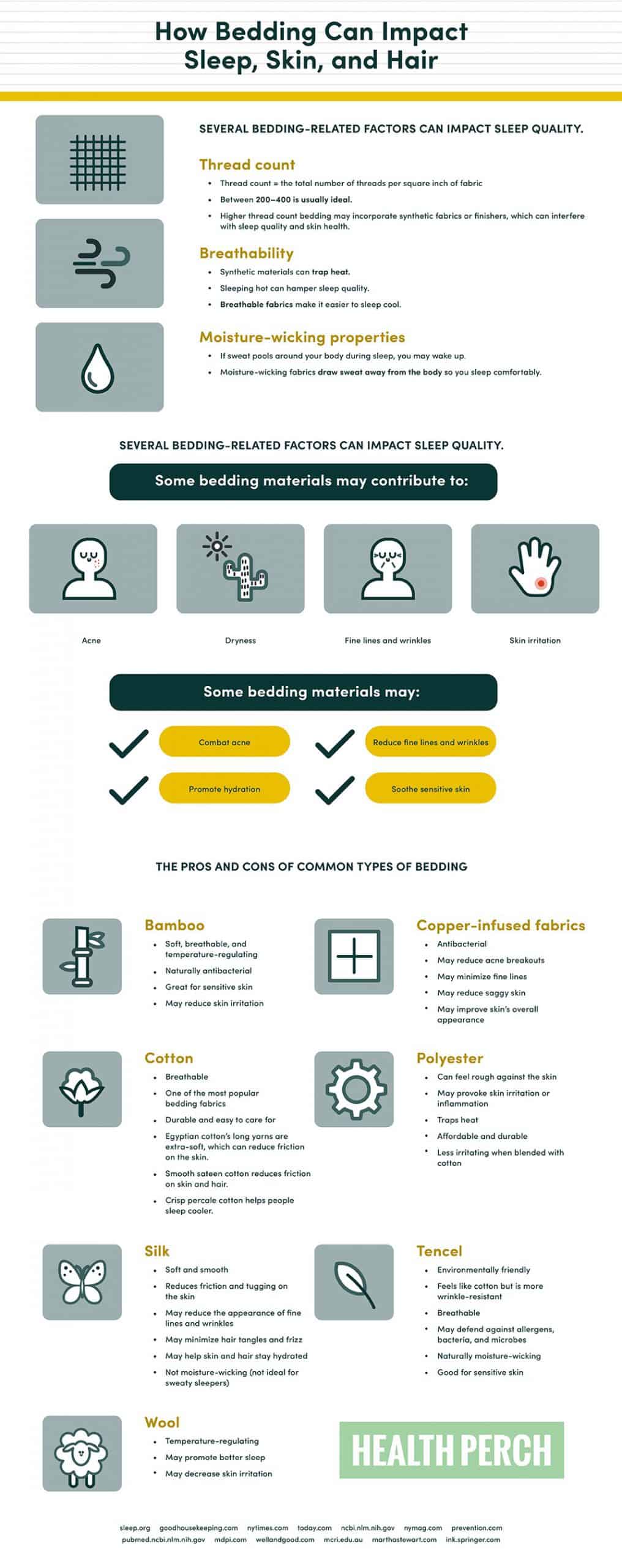
In the market for new bedding? There’s more to think about than color and budget. Factors such as fabric and thread count can impact not just the touch and feel of your bedding but also your sleep quality, skin, and hair. Read on for some sheet smarts to make beauty sleep a reality.
Bedding Factors that Can Impact Sleep Quality
When it comes to bedding, several factors can impact sleep quality. Here’s a snapshot of how your bedding can impact your sleep.
Thread Count
Quality sheets and quality sleep go hand in hand. Thread count, or the total number of threads per square inch of fabric, is usually the first determining factor of quality. But a high number isn’t necessarily better.
The sweet spot for thread count is generally between 200 and 400. Manufacturers likely achieve anything more than that with synthetic fabrics or finishers, which can negatively impact sleep and reduce the lifespan of your sheets. Synthetic fabrics trap heat and cause skin irritation, which can make it harder to get comfortable enough to fall and stay asleep.
Keep in mind that thread count only matters with cotton sheets; other fabrics are either sold by weight or list a misleading thread count. In the market for cotton sheets? Check the label for 100 percent long-staple cotton. Companies can get away with labeling lower quality cotton blends as Egyptian if the fabric originated in the country, and sheets with shorter-staple fibers generally have a rougher texture.

Breathability
Synthetic materials can trap heat, which could make you too hot to sleep comfortably. One review of studies showed that a person’s thermal environment — or the factors that affect body temperature, such as bedding, clothing, and room temperature — plays a large part in sleep, and heat contributes to wakefulness. Temperatures between 60 and 67 degrees Fahrenheit are ideal for sleep, so opt for breathable fabrics such as cotton, bamboo, or Tencel that will allow for the most airflow.
Materials
The materials that make up various bedding products can have a big impact on comfort. And comfort can mean the difference between a sound night’s sleep or tossing and turning. We’ll review the pros and cons of common bedding materials in the next section.
Moisture-wicking properties
If you wake up with night sweats or you’re going through menopause, then you know overheating can disrupt sleep. Prone to sleeping hot? Look for sheets with moisture-wicking materials such as Tencel; this eucalyptus-derived fabric absorbs moisture well. These sheets help pull moisture away from the body, which helps you stay cool and decreases the chances you’ll wake up because of overheating.
Sleep and Beauty: The Pros and Cons of Common Bedding Materials
Bedding doesn’t only have an impact on sleep. It can also affect skin and hair health. Let’s take a look at the pros and cons of some of the most common bedding materials — with the aim of getting you some bona fide beauty sleep.
Bamboo
Eco-friendly bamboo sheets are soft, breathable, and temperature-regulating. Bamboo is naturally antibacterial and great for sensitive skin because of its hypoallergenic properties. Bacteria and dust mites can’t survive in bamboo, which minimizes potential skin irritants. Some research suggests the viscose found in bamboo may even prevent skin irritation.
Copper
Pillowcases with copper-oxide particles embedded in the fabric could possess antibacterial and healing properties that help reduce acne breakouts and wrinkles. One study found that sleeping on copper pillowcases reduced fine lines and improved skin’s overall appearance. Another study found that copper-infused bedding could reduce saggy skin and maintain firmness.
Cotton
Cotton is one of the most popular bedding fabrics for a reason: It’s durable, breathable, easy to care for, and reasonably priced. There are several varieties, with long-staple Egyptian cotton considered the most luxurious. The long yarns make it softer than its counterparts, which helps reduce skin friction.
The weave of cotton sheets can impact their feel and durability. Percale cotton has a close weave that keeps sheets crisp and durable, which produces a more breathable fabric for those that sleep hot. Sateen creates a softer finish, but it can be less durable over time. The smoothness of sateen mimics silk and allows skin and hair to glide over the fabric with minimal friction.
Polyester
Synthetics such as polyester can feel rough against the skin and cause irritation and inflammation, particularly if you have skin conditions (such as eczema). Polyester also traps heat and tends to produce static electricity. However, the human-made fabric is cheaper and more durable if you need sheets that will last for several years. When blended with cotton, polyester sheets are softer, less likely to cause irritation, and longer-lasting than 100 percent cotton.
Silk
The smoothness of silk provides many more benefits than just feeling luxurious against the skin. If you toss and turn at night, the silky texture will allow your skin to slide around with no friction, which could reduce the appearance of fine lines and wrinkles. (While it’s not a proven theory, if you’ve ever woken up with creases on your face, it could be due to a non-silken pillowcase.)
Same goes for hair — the softness of silk can reduce the tangles and frizz that can occur in the face of friction from synthetic bedding. Silk is not moisture-wicking like cotton or Tencel, so it may not be a good idea if you sweat at night. On the other hand, if you suffer from dry skin or dry hair, silk can maintain hydration while you sleep since it won’t wick moisture away from the skin.
Tencel
Tencel is a more environmentally friendly material made from eucalyptus tree wood pulp. It feels like cotton but is more wrinkle-resistant and very breathable. Research suggests Tencel may deter allergens, bacteria, and microbes, which reduces irritants that could aggravate sensitive skin. And its natural moisture-wicking properties are great for sweaty sleepers who want to sleep more comfortably.
Wool
Coats made of thick wool may be rough and scratchy, but one study found that soft merino wool is temperature-regulating and can even contribute to better sleep. Another study demonstrated that, compared to cotton, wool decreases skin irritation in kids with eczema. If you prefer the weighted feel of a duvet, try a duvet with wool; it’ll keep you cool in the summer thanks to its moisture-wicking abilities, but it will retain heat in the winter to keep you warm.
How to Care for Bedding
Best practices for washing and drying bedding will vary depending on material, so it’s important to follow the tag instructions. That said, here are some general bedding care guidelines that apply in most cases.
- Wash new sheets before sleeping on them to remove any irritants from the packaging.
- Opt for fragrance-free detergent to avoid additional skin irritants. Bonus points for choosing an eco-friendly detergent, which is good for your skin and Mother Nature.
- Wash sheets at least at least every two weeks to remove dead skin cells and dust mites.
- If you get breakouts, change your pillowcase at least once a week. Residue from your body oils and skin and hair products can seep into pillowcases and exacerbate acne.
- Hot water may fade colors but use the warmest setting possible to kill germs.
- Dry bedding on a low setting to extend its lifespan.
- Don’t forget your pillows! Wash pillows on a gentle cycle once a season to remove dust mites and allergens. Dry on a cool setting with dryer balls to maintain fluffiness.
- Frequent washing and drying will eventually wear down the fibers in bedding, so donate, recycle, or toss sheets after about 18 to 24 months.
Conclusion
Bedding can have a significant impact on sleep quality and skin and hair health, so it’s important to shop wisely. Many dermatologists agree that sleeping on smoother fabrics can result in healthier skin and softer hair. Invest in quality linens and take proper care of them to extend the lifespan of bedding, reduce possible skin irritants, and promote quality sleep.
